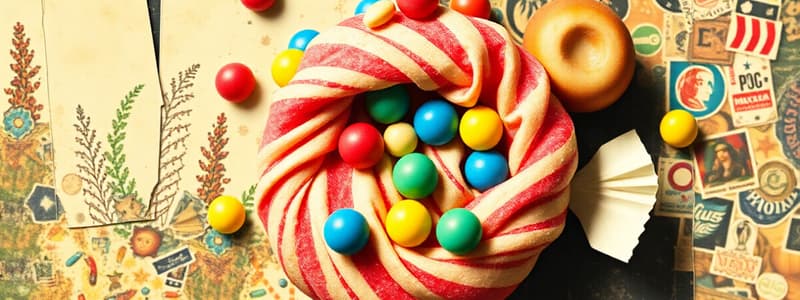Podcast
Questions and Answers
What role does the packaging and color of candies play in their appeal?
What role does the packaging and color of candies play in their appeal?
- It has little to no effect on their appeal.
- It only attracts children, not adults.
- It is primarily focused on the nutritional information.
- It significantly enhances their nostalgic value. (correct)
Which characteristic was common in candy marketing during the 80s and 90s?
Which characteristic was common in candy marketing during the 80s and 90s?
- Catchy jingles and TV commercials. (correct)
- Health-focused advertisements.
- Minimalistic packaging designs.
- Focus solely on international markets.
Why is understanding context important when using sarcasm in the workplace?
Why is understanding context important when using sarcasm in the workplace?
- Context is irrelevant when expressing sarcasm.
- Only to impress colleagues with wit.
- To ensure humor translates into higher salaries.
- To avoid misunderstandings that could offend others. (correct)
What often characterizes construction-themed jokes?
What often characterizes construction-themed jokes?
What is a possible consequence of misinterpreting sarcasm in the workplace?
What is a possible consequence of misinterpreting sarcasm in the workplace?
What type of humor is commonly associated with construction jokes?
What type of humor is commonly associated with construction jokes?
Which of the following statements best describes the effect of sarcasm in a workplace environment?
Which of the following statements best describes the effect of sarcasm in a workplace environment?
Why might humorous candy evoke nostalgia for some individuals?
Why might humorous candy evoke nostalgia for some individuals?
Flashcards
Sarcasm
Sarcasm
A form of humor that relies on irony, often implying the opposite of what is said, often used to subtly criticize or disagree.
Construction Jokes
Construction Jokes
The use of exaggerated or absurd situations in jokes, often relating to tools, materials, or the physical nature of construction work.
80s and 90s Candy Trends
80s and 90s Candy Trends
Candies from the 80s and 90s often featured bright colors, cartoon-themed packaging, and unique flavors, sometimes tied to regional variations.
Candy Nostalgia
Candy Nostalgia
Signup and view all the flashcards
Workplace Sarcasm
Workplace Sarcasm
Signup and view all the flashcards
Construction Puns
Construction Puns
Signup and view all the flashcards
Subjective Humor
Subjective Humor
Signup and view all the flashcards
Workplace Sarcasm Impact
Workplace Sarcasm Impact
Signup and view all the flashcards
Study Notes
Funny Candy
- Many candies are associated with nostalgia, particularly from the 1980s and 1990s.
- Specific candies like Skittles, Starburst, and jelly beans evoke strong positive feelings and memories for some people.
- The packaging and colors of these candies often play a major role in their appeal.
- The perception of humor is subjective, varying from person to person.
- The sweet taste of candy can sometimes be associated with happiness or a positive mood.
80s and 90s Candy Trends
- Candy trends of the 1980s and 1990s often involved brightly colored, cartoon-themed packaging.
- Novelty candies and unique flavors were popular.
- The availability of candy often varied regionally.
- Certain candies became iconic symbols of their respective eras.
- Marketing campaigns frequently used catchy jingles or TV commercials.
Construction Jokes
- Construction-themed jokes often rely on puns related to tools, materials, or the work's physical aspects.
- Humor in construction jokes commonly relies on exaggerating or making situations absurd.
- Jokes sometimes play on the physical demands of construction work or potential accidents.
- Wordplay and situational humor are common elements.
- Construction puns may focus on specific tools, techniques, or field terminology.
Sarcasm in the Workplace
- Sarcasm involves using irony, often as humor at someone else's or an event's expense.
- Sarcasm in the workplace can range from playful banter to harsh remarks.
- Understanding context and the recipient's tolerance level is crucial in the workplace.
- Misinterpretations of sarcasm can lead to offense, conflict, or damaged relationships.
- Delivered insincerely, sarcasm might use witty, critical, or satirical language to imply the opposite of what is being expressed.
- Sarcastic comments can negatively affect the workplace environment for some and are often deemed inappropriate or offensive.
- Using sarcasm in professional settings needs careful consideration of the audience and potential consequences.
- Context is essential for interpreting sarcasm's intent and tone.
- Sarcasm can be a subtle way to express criticism or disagreement.
- Cultural differences can significantly influence perceptions and use of sarcasm in different workplaces.
- Excessive or inappropriate use of sarcasm can hinder employee efforts and disrupt teamwork.
- Clear communication avoids misunderstandings caused by sarcasm.
Studying That Suits You
Use AI to generate personalized quizzes and flashcards to suit your learning preferences.





